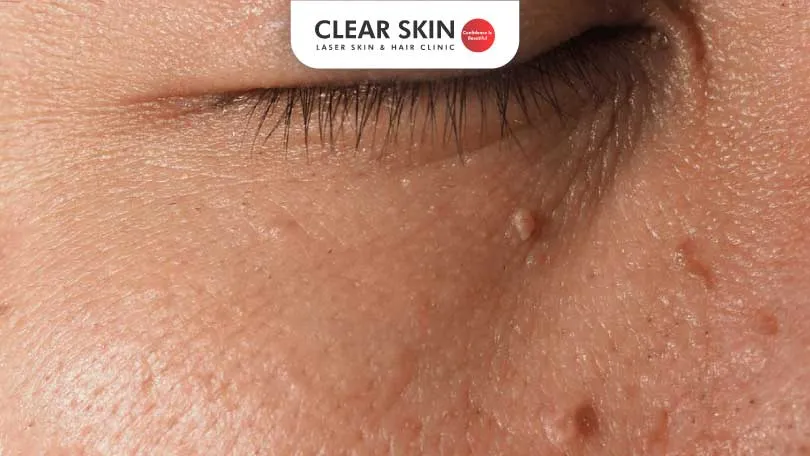Reviewed By:
Updated on: 24th April, 2023
Many people don’t know what wart is, so If you can see a hard bump rough growth over your face, finger or any other part of your body, which has a cauliflower appearance then it might be a wart. When this hard rough bump is seen over the face, then it will affect the individual cosmetically, then this question might be striking in their mind, “How to remove warts from the face?”.

Table Of Content
- What are Warts?
- Types of Warts
- Causes of Facial Warts
- How to Remove Warts from the Face?
- How to Prevent Warts on Face?
- When to Consult a Dermatologist?
- Conclusion
What are Warts?
A wart is a skin condition caused by a virus known as the Human papillomavirus (HPV). Warts are usually smaller in size, with raised bumps over a skin. And it appears like a small cauliflower or solid blister, but its actual appearance will depend upon the location of the body.
Individuals with a weakened immune system can get warts easily. Warts are not life-threatening but they are highly contagious and it appears ugly, therefore it might be embarrassing & hence it will be bothering the individual who is suffering from warts. In some cases, the wart can be painful also.
Warts are most commonly seen in children as compared to adults because in children the immune system is weaker as compared to adults.
Types of Warts
There are various types of warts, among which these six types of warts are commonly seen, they are Common warts, Flat warts, Filiform warts, Plantar warts, Periungual warts, Genital Warts. This type of wart seen on a different part of the body and hence it has its own distinct appearance
Common warts or verruca Vulgaris:
Common warts occur anywhere but they are most commonly seen over the back of fingers, toes & around the nails, knuckles, elbows, knees, and any area with broken skin. It is rough with grainy appearance, & it is more grey in color as compared to the surrounding skin. Common warts mostly resemble cauliflower. In this type of wart, some individuals notice black dots over wart i.e clotted blood vessels that can lead to bleeding.
Black dots in the wart are blood vessels that can lead to bleeding known as seed wart.
Plantar warts:
Plantar warts are the types of warts, which can be seen over the base of the foot. And it appears over the soles of the feet, heels, and toes. This type of wart usually grows into the skin, because the human body’s weight pushes onto the sole of the foot. In plantar warts, you will notice a small hole in the bottom of your foot, which will be surrounded by hardened skin. Plantar warts can be painful and difficult to clear-up completely.
Flat warts or verruca plana:
These types of wart are round, flat, and smooth. They usually grow over the face, thighs, or arms. They can be pink, brownish, slightly yellow or skin-colored. Flat warts appear smaller in size with a flat top, therefore it cannot be noticed immediately. In male due to shaving, it can appear in a linear distribution. It can range from 20 to 100.
Filiform warts:
Filiform warts are small & it can appear like a skin tag or like a long stalk like a thread. They occur around the mouth, nose and often on your neck or under your chin. Filiform warts have the same color as what your skin has.
Periungual warts:
Periungual warts can be the most painful warts because they grow under and around the toenails and fingernails.
Genital warts:
Genital warts are one of warts which is more contagious. It can grow in and around the genitals. Genital warts are generally harmless, but they can be harmful in women and male. In women, if the warts are present in cervical, anal and vulvovaginal because it can cause cancer on the affected part. Some types of a wart can cause cancer in men such as anal cancer and cancer of the glans penis. Therefore if anyone gets genital warts, it will require a doctor’s assessment.
Causes of Facial Warts
As I mentioned earlier that 2 types of wart are seen over the face, 1st is Filiform warts & 2nd is a flat wart. Filiform warts are long and have thin projections which help to give them distinct projections over the skin. And flat warts are flat.
Flat warts or Filiform warts are caused by the virus known as human papillomavirus (HPV). The wart can easily be spread through the skin to skin contact but the risk of the infection is higher if the skin is broken.
How to Remove Warts from the Face?
Anyone who is looking to get rid of warts from their face, then here is good news for them, that warts over the face can be removed effectively with some medical treatments such as.
1) Topical creams:
- For wart treatment, your doctor may prescribe you cream containing 5-fluorouracil, imiquimod, or benzoyl peroxide which will help to loosen up wart, so that it will fall off easily.
- If this topical treatment doesn’t work for you then your doctor will advise you some advanced medical procedural treatment, because it is more effective than any other treatment with no or less scarring.
- It also helps to stop the spread of warts.
2) Cryotherapy :
- Liquid nitrogen spray (-196 °C) used to produce freeze and thaw cycles which destroy the superficial skin cells and the viral particles inside the cells
- Multiple sessions required
- Slight pain, redness and blistering can be expected
3) Radiofrequency Ellman:
- Uses high-frequency alternating current to generate heat which then used to cut or coagulate the tissue
- Superficial lesions removed clean with almost no scarring
- Minimum scarring can occur in deeper lesions
4) CO2:
- Acts in a similar way – the lesion to be removed burnt/cauterized using laser energy.
5) PPD injection (intralesional immunotherapy):
- PPD (purified protein derivative) injected inside and below the wart to cause immune modification and delayed hypersensitivity which causes the wart to regress.
6) Autoinoculation:
- Autoinoculation is a surgical treatment where a wart is removed, crushed and a part of it is then surgically inoculated at subcut level inside the patient’s thigh.
- It acts by causing a heightened immune response to the particular strain of the virus causing regression of the lesions and prevents recurrence.
- Done for multiple recurrent lesions.
7) Chemical peel:
The salicylic peel will soften the wart. Again multiple sessions will be required to get an effective result.
How to Prevent Warts on Face?
Proper prevention to be taken so that the risk of getting affected by wart will reduce:
- If you are having a wart, then avoid touching your existing wart.
- Do not scratch your wart, because it will cause them to spread.
- Wash your hand immediately if you touch your wart.
- Keep your hand dry as much as you can.
- Do not touch infected people’s warts.
- Do not touch wart sufferers towel or personal belongings
- If you are a swimmer then do not share your towel or napkin, bring your personal belongings.
- Wear sandals or slippers while entering & exiting from communal showers & pools.
- While swimming covers your wart with a waterproof covering.
- In the gym, wear socks & gloves, so that you will not get warts from others.
- Avoid sharing your shoes or socks with others.
- Avoid combing, brushing, shaving over infected areas, because it will increase the infection.
- Over nail- while cutting your nail, use 2 different nail cutter utensils, so that you will use a separate nail cutter over infected & non-infected nails.
- Avoid nail bite habits.
If you want more information regarding wart, please ask your questions. A wart can cause more embarrassment, therefore it is better to treat your wart, rather than avoiding it.
When to Consult a Dermatologist?
Conclusion
Popular Q&As
Confused about whether diet causes acne? Get clear answers on food triggers, myths, and evidence-based guidance for better skin. Find the right medicine for acne vulgaris — from topical retinoids and benzoyl peroxide to oral antibiotics and hormonal options. Get ClearSkin’s dermatology-backed guide. Understand why dark circles appear and how to treat them permanently. Expert solutions, safe procedures, and skin care advice from dermatologists in Pune.
What is the link between Acne and Diet?
Best Medicine for Acne Vulgaris?
How to Remove Dark Circles Under your Eyes Permanently?
We Got Your Back! Ask Us Anything On Your Mind!
Reach out to us on
Didn’t Find What You Were Looking?
Please Contact Us.
We are committed not only to treating you, but also educating you.

